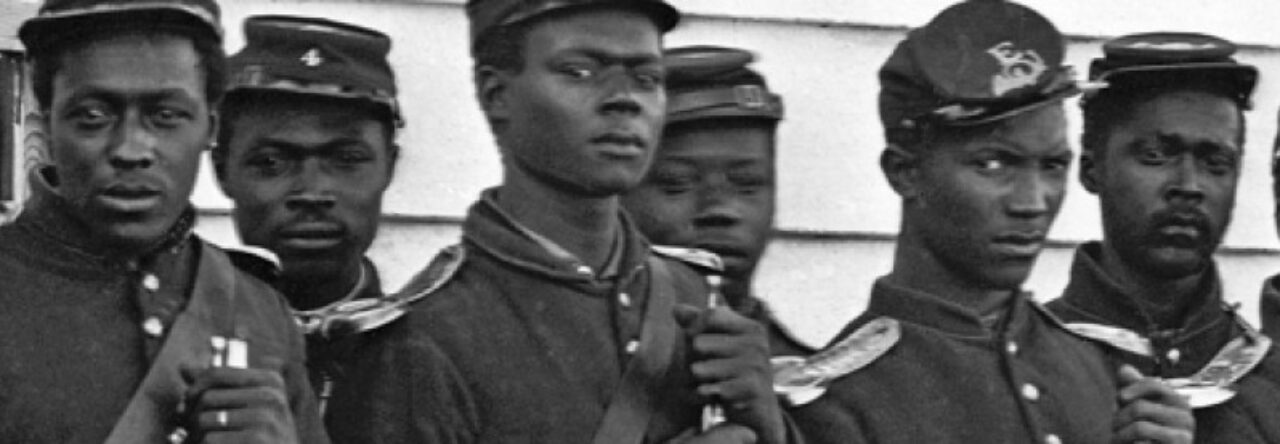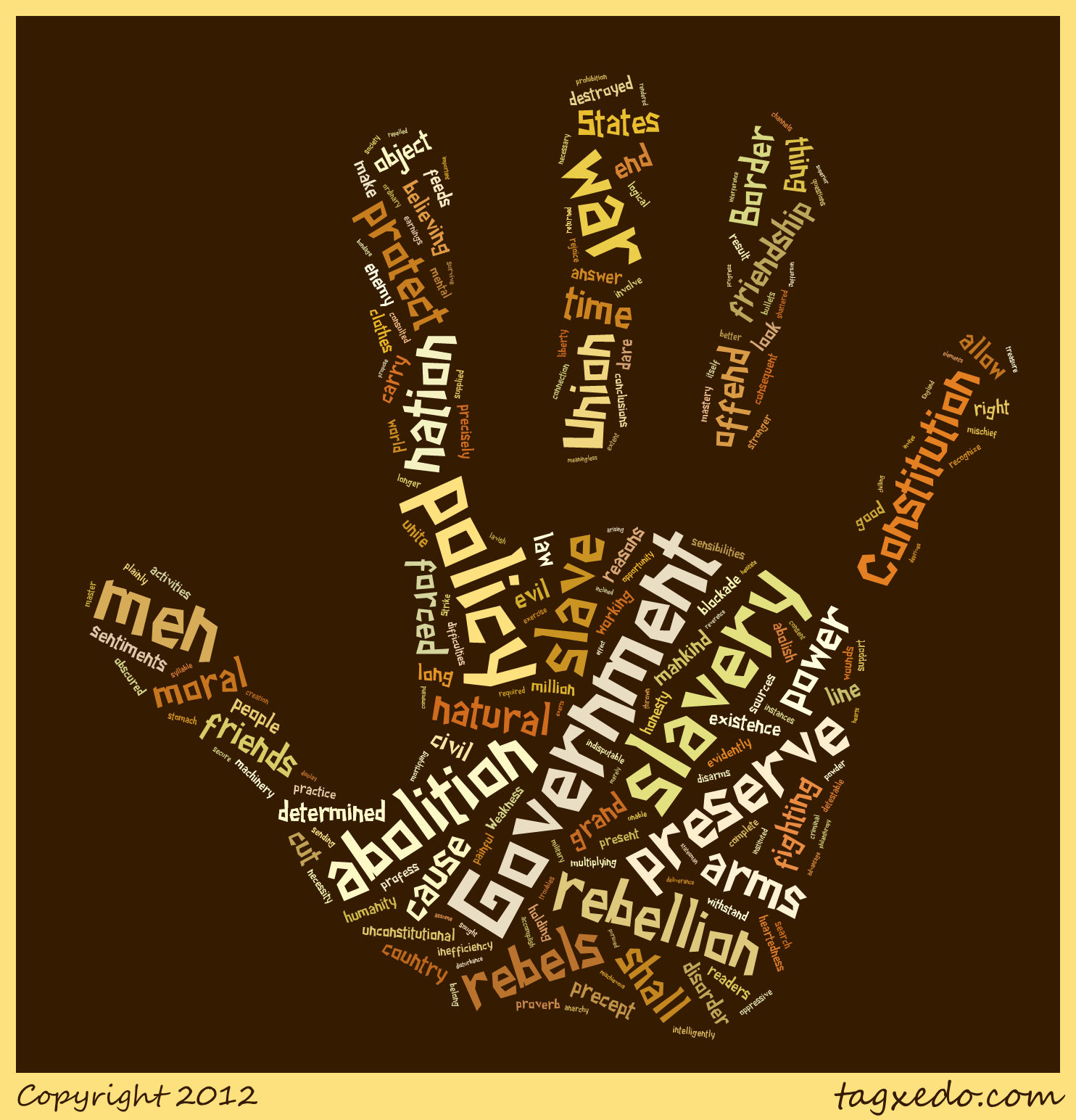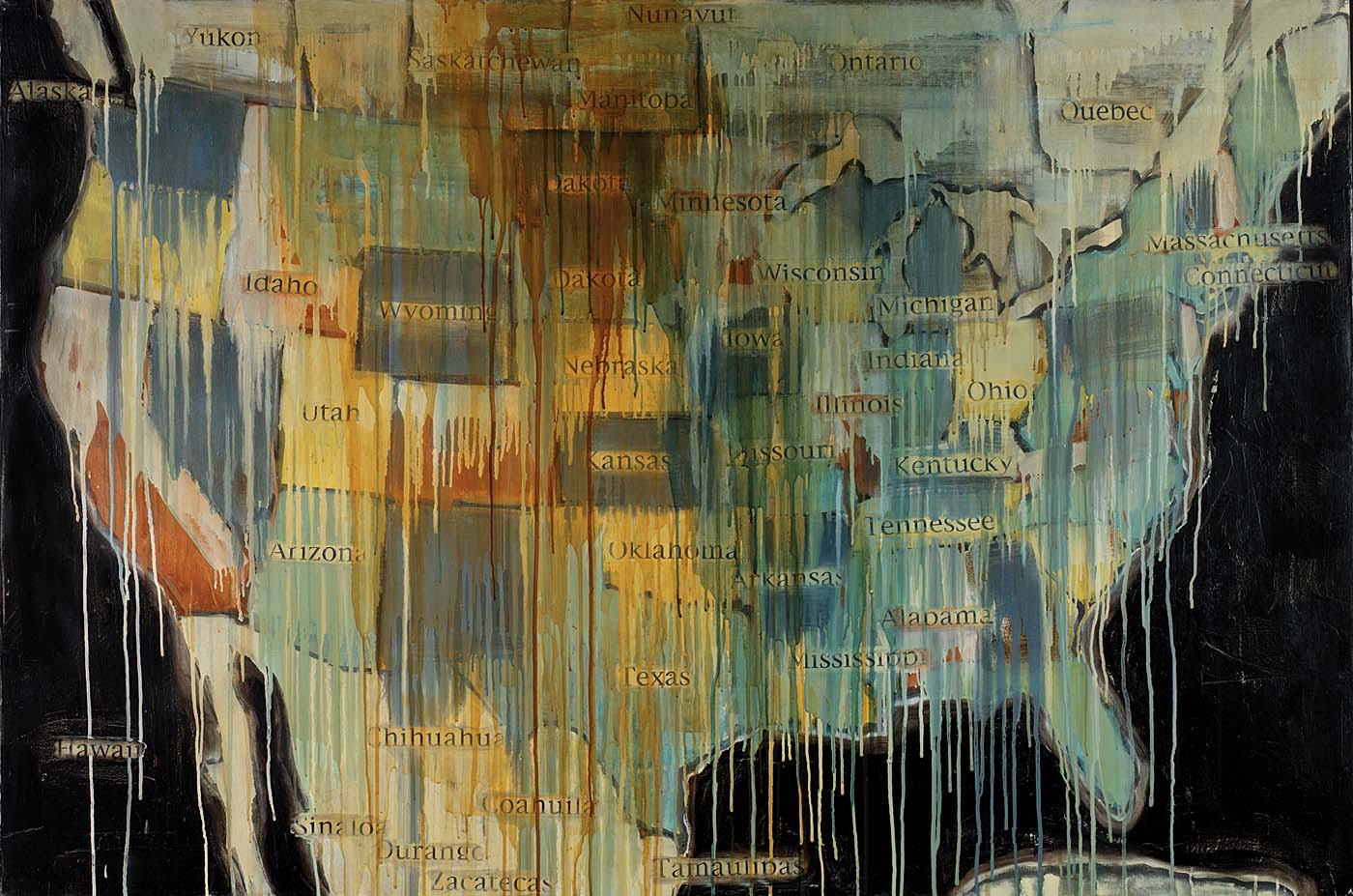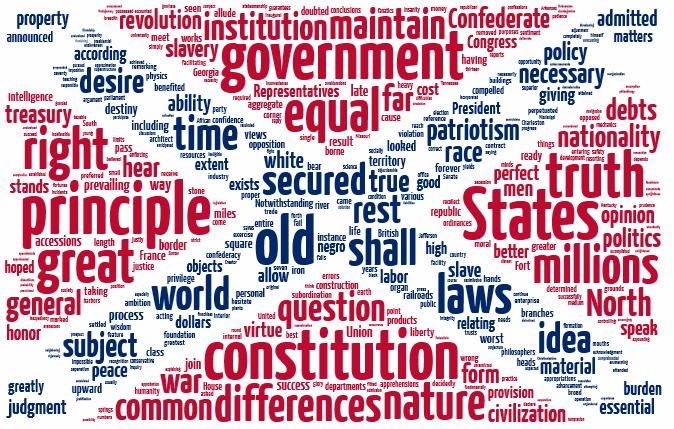Category: Word Clouds Page 1 of 2
I started the new year with a piece of art to begin a conversation. The piece:
State Names; 2000; Jaune Quick-To-See Smith; Born: St. Ignatius, Montana; 1940; oil, collage and mixed media on canvas; 48 x 72 in. (121.9 x 182.9 cm); Smithsonian American Art Museum Gift of Elizabeth Ann Dugan and museum purchase; 2004.28; Smithsonian American Art Museum
Here are some of their insights:
It has a rusty red color on the top of it to represent the war
A new generation is coming and the old generation is being stripped away
Caging in America
Chaotic Unification
It looks like it is all moving together into one
Dying … disintegrating … falling apart … no one knows what’s going on
Some names have drips covering them but the others seem to pop out
It looks like melting wax
Something is spreading down, like war or migration
Bloody death
It looks like war. And it looks like everything is falling apart.
The top right states look like the drops are icicles
Blood running down Dakota… most bloodshed there
The oceans are black yet the Great Lakes are grey
Everything to the east side has no borders … like one big state
I played with Tagzedo to create a word cloud of their observations.
Standard: Kansas History
Benchmark 3: The student understands individuals, groups, ideas, events, and
developments of the territorial period and the Civil War in Kansas.
This student will:
1. explain the concept of popular sovereignty under the Kansas-Nebraska Act. 2. explain why control of the Kansas territorial government was affected by the fight over slavery. 3. describe the influence of pro-and anti-slavery ideas on territorial Kansas (e.g., Bleeding Kansas, border ruffians, bushwhackers, jay-hawkers, the Underground railroad, free state, abolitionist). 4. describe the causes and consequences of Quantrill’s Raid on Lawrence during the Civil War
These are just parts of some of our 7th grade standards in Kansas for my unit I thought I would concentrate on the time period between the Kansas-Nebraska act and Quantrill’s raid .
. 
William Clarke Quantrill
(1837-1865)
Leader of perhaps the most savage fighting unit in the Civil War, William Quantrill developed a style of guerrilla warfare that terrorized civilians and soldiers alike. Quantrill was born in 1837 in Ohio, but little is known of his early life. It appears that after being a schoolteacher for several years, he travelled to Utah in 1858 with an army wagon train and there made his living as a gambler, using the alias of Charles Hart. After a year, he moved to Lawrence, Kansas, where he was again a schoolteacher from 1859 to 1860. But his past and predisposition soon caught up with him and, wanted for murder and horse theft, Quantrill fled to Missouri in late 1860..
This is obviously a work in progress but my plan is to have two google maps one of Quantrill’s entrance into Kansas from Missouri and of his masterful escape out of Kansas, the other would be a google map of Lawrence, ks and the location of the murders and destruction maybe even a virtual tour.
Every time I listen to a lecture, attend a conference, find new material and new ways of thinking about the Civil War I have to rethink how I teach it. I only have two weeks, maybe three at the most if I stretch it, to teach the Civil War from start to finish including what led up to it. How to choose the most important parts to teach and then how to effectively teach them is a real struggle for me. I find that students tend to remember things much better when emotion is attached to whatever they are learning. I have been moved to tears a few times when reading soldiers’ letters home over the last few days and I think this is a valuable tool.
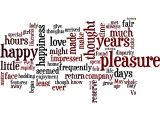 I decided to do my Wordle experiment with the words of a very sweet love letter from a soldier to his wife. I thought this might be a good introduction to both Wordle and the real experiences of war as seen from the primary sources of letters written by soldiers of both sides of the war.
I decided to do my Wordle experiment with the words of a very sweet love letter from a soldier to his wife. I thought this might be a good introduction to both Wordle and the real experiences of war as seen from the primary sources of letters written by soldiers of both sides of the war.
This is something I intend to use. I think the emotion from the voices of the soldiers tell the story of the war very well. As I have read in more than one place, how great it is that during the Civil War there was no censorship of the soldiers’ letters so we can see the honest feelings of the men. My sudents will connect with this.
I was mucking about with Tagxedo…
I am fascinated with pro-slavery thought. My younger self believed the planter class lived in a sad state of denial, not knowing the wrongs they committed. A bit later, I wondered at the stress that must have consumed those whose hands held the wolf’s ears. It’s not that I never felt deeply for the slaves, or at all blamed enslaved people for their condition and treatment. I don’t blame victims.
But I am curious about the mindset of victimizers; perhaps there may be some future value in that understanding. Among the most interesting elements of the buildup to the Civil War was the reaction of Southern political leaders to the pending ascendancy of the Republican party, especially among the most eloquent pro-slavery speakers.
Alexander Stephens is represented above, in his Cornerstone speech of March 21, 1861. “Our new government is founded upon exactly the opposite idea; its foundations are laid, its corner- stone rests, upon the great truth that the negro is not equal to the white man; that slavery subordination to the superior race is his natural and normal condition.”
Fascinating.
Sorry… this isn’t a deeply introspective connection between the late Mr. King and the CW. I am thinking much more shallowly (there’s one for my Language Arts friends) about the famous video of his beating. Remember how obvious the issue seemed when we first saw it? But the case got more and more complicated as the trial progressed, enticing people to consider that what we saw wasn’t what actually happened, that seeing wasn’t believing and there was so much more to the incident. I don’t think my students would have followed such entreaties. What they see is what they see.
We may consider developmental stages, but regardless of that there is elegance in their distillation of causes… of course the CW was about slavery… like, duh.
But how was it about slavery? How can we prove it? Can we use the words of the central actors to establish the true causes of the war? Lincoln went there, at least in part, in his Second Inaugural:
“All knew that this interest was, somehow, the cause of the war. To strengthen, perpetuate, and extend this interest was the object for which the insurgents would rend the Union, even by war; while the government claimed no right to do more than to restrict the territorial enlargement of it.”
Then he went into the similarities of both sides, laying the groundwork for his renowned “charity for all”:
“Neither party.. Neither anticipated.. Each looked… Both read… and each invokes… but let us judge not… prayers of both… neither has been…”
Words expressing commonality, but words in common, too.
Despite the relentless nature of anywhere “content,” words matter. The right words impel people to fight, make love, vote, revolt, endear, die.
Here, though, I have a problem. Our 8th graders are now largely visual learners, and simply compelling them to parse historical texts is less effective than it has ever been. While I’ve heard the jargon of “differentiated instruction” and “learning styles” ad mortem, the reality is that my kids can’t read Lincoln. Really, they can’t derive much meaning from what they read, whether it is historical or contemporary. This is a generality, but it’s true enough to drive the organization of my classroom.
 To deal with the YouTube reality, I start with the importance of discrete words, then work my way up to quotes and passages, then to letters and documents. **
To deal with the YouTube reality, I start with the importance of discrete words, then work my way up to quotes and passages, then to letters and documents. **
Below are seven word clouds. The fonts, layout and colors are the same – purposefully. I ask kids to compare and contrast between the different clouds, and only at that point do I explain a bit about each. Once we find common words we can begin to get at causes.

Declaration of the Immediate Causes Which Induce and Justify the Secession of South Carolina from the Federal Union
**To this end we’ve started teaching basic Latin in our Language Arts classes, in an effort to better connect our kids to words. By the end of the year most of my kids could at least understand what I meant by, “casus belli.”
Ignore me, I’m playing.
I have given kids Wordle versions of their research papers before and so wanted to see what Tagzedo could do:
The first is a paper by a young lady who suggested that total war was as much a moral wrong as slavery itself. I tell them if they see “I would have read this one for free” on their paper, I really liked it. She got her paper back and that was the only comment she looked for. It was there. Probably one of the best I’ve read in seven years.
I love that ‘slave war’ ran through the south and ‘destruction land’ across the north. Completely random.
The second paper did not have that commendation on his paper but I loved the ambition of his thesis. The South lost Gettysburg due to arrogance, disregard of orders and poor execution. I’d rather them be ambitious and come up short (I love helping them get the rest of the way) rather than striving for the mediocre.
I love that Longstreet connects the fuse on this one. Its like the guy who designed Longstreet’s statue at Gettysburg now works at Tagzedo.
This is my first exploration with Wordle. I uploaded Lincoln’s House Divided Speech, ca. 1857-1858. This tool could be very effective and details Lincoln’s main points of the speech. However, I am having difficulty increasing the size of the text. I was unable to directly embed the code from Wordle. Does anyone have any suggestions?
Wordle could be a valuable tool for my AP US History students. They could upload a primary source document from a DBQ, which would help them choose the salient outside information to include in their essay.
In addition, I have found that university campuses offer a wide breadth of local history. For my AP Human Geography course, I took my students to the University of Pennsylvania campus for a historical architecture tour that I developed. In addition, to discussing the buildings, a large number of historical figures were discussed as well. I can invision similar historical tours at universities around the country.
 I truly love this haunting letter written by Sullivan Ballou to his wife just one week before he was killed at the First Battle of Bull Run. So interesting and beautiful to see how it is represented in a word cloud.
I truly love this haunting letter written by Sullivan Ballou to his wife just one week before he was killed at the First Battle of Bull Run. So interesting and beautiful to see how it is represented in a word cloud.
THE LETTERJuly the 14th, 1861
Washington D.C.
My very dear Sarah:
The indications are very strong that we shall move in a few days—perhaps tomorrow. Lest I should not be able to write you again, I feel impelled to write lines that may fall under your eye when I shall be no more.
Our movement may be one of a few days duration and full of pleasure—and it may be one of severe conflict and death to me. Not my will, but thine O God, be done. If it is necessary that I should fall on the battlefield for my country, I am ready. I have no misgivings about, or lack of confidence in, the cause in which I am engaged, and my courage does not halt or falter. I know how strongly American Civilization now leans upon the triumph of the Government, and how great a debt we owe to those who went before us through the blood and suffering of the Revolution. And I am willing—perfectly willing—to lay down all my joys in this life, to help maintain this Government, and to pay that debt.
But, my dear wife, when I know that with my own joys I lay down nearly all of yours, and replace them in this life with cares and sorrows—when, after having eaten for long years the bitter fruit of orphanage myself, I must offer it as their only sustenance to my dear little children—is it weak or dishonorable, while the banner of my purpose floats calmly and proudly in the breeze, that my unbounded love for you, my darling wife and children, should struggle in fierce, though useless, contest with my love of country.
Sarah, my love for you is deathless, it seems to bind me to you with mighty cables that nothing but Omnipotence could break; and yet my love of Country comes over me like a strong wind and bears me irresistibly on with all these chains to the battlefield.
The memories of the blissful moments I have spent with you come creeping over me, and I feel most gratified to God and to you that I have enjoyed them so long. And hard it is for me to give them up and burn to ashes the hopes of future years, when God willing, we might still have lived and loved together and seen our sons grow up to honorable manhood around us. I have, I know, but few and small claims upon Divine Providence, but something whispers to me—perhaps it is the wafted prayer of my little Edgar—that I shall return to my loved ones unharmed. If I do not, my dear Sarah, never forget how much I love you, and when my last breath escapes me on the battlefield, it will whisper your name.
Forgive my many faults, and the many pains I have caused you. How thoughtless and foolish I have often been! How gladly would I wash out with my tears every little spot upon your happiness, and struggle with all the misfortune of this world, to shield you and my children from harm. But I cannot. I must watch you from the spirit land and hover near you, while you buffet the storms with your precious little freight, and wait with sad patience till we meet to part no more.
But, O Sarah! If the dead can come back to this earth and flit unseen around those they loved, I shall always be near you; in the brightest day and in the darkest night—amidst your happiest scenes and gloomiest hours—always, always; and if there be a soft breeze upon your cheek, it shall be my breath; or the cool air fans your throbbing temple, it shall be my spirit passing by.
Sarah, do not mourn me dead; think I am gone and wait for me, for we shall meet again.
As for my little boys, they will grow as I have done, and never know a father’s love and care. Little Willie is too young to remember me long, and my blue-eyed Edgar will keep my frolics with him among the dimmest memories of his childhood. Sarah, I have unlimited confidence in your maternal care and your development of their characters. Tell my two mothers his and hers I call God’s blessing upon them. O Sarah, I wait for you there! Come to me, and lead thither my children.
-
- Sullivan
:
Sullivan Ballou was killed a week later at the first Battle of Bull Run, July 21, 1861.
Born March 28, 1829 in Smithfield, R.I., Ballou was educated at Phillips Academy in Andover, Mass.; Brown University in Providence, R.I. and the National Law School in Ballston, N.Y. He was admitted to the Rhode Island Bar in 1853.
Ballou devoted his brief life to public service. He was elected in 1854 as clerk of the Rhode Island House of Representatives, later serving as its speaker.
He married Sarah Hart Shumway on October 15, 1855, and the following year saw the birth of their first child, Edgar. A second son, William, was born in 1859.
Ballou immediately entered the military in 1861 after the war broke out. He became judge advocate of the Rhode Island militia and was 32 at the time of his death at the first Battle of Bull Run on July 21, 1861.
When he died, his wife was 24. She later moved to New Jersey to live out her life with her son, William, and never re-married. She died at age 80 in 1917.
Sullivan and Sarah Ballou are buried next to each other at Swan Point Cemetery in Providence, RI. There are no known living descendants.
Ironically, Sullivan Ballou’s letter was never mailed. Although Sarah would receive other, decidedly more upbeat letters, dated after the now-famous letter from the battlefield, the letter in question would be found among Sullivan Ballou’s effects when Gov. William Sprague of Rhode Island traveled to Virginia to retrieve the remains of his state’s sons who had fallen in battle. – information taken from pbs.org
